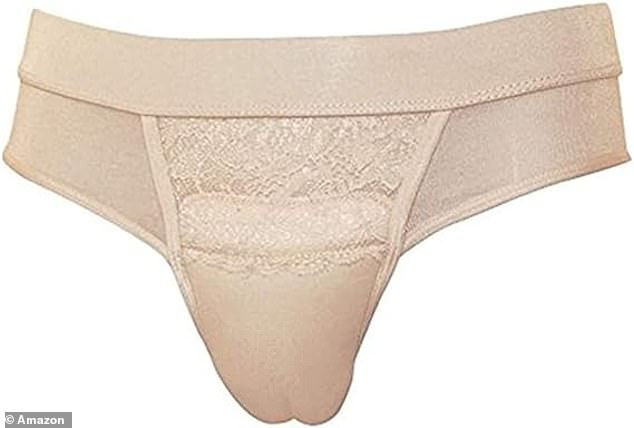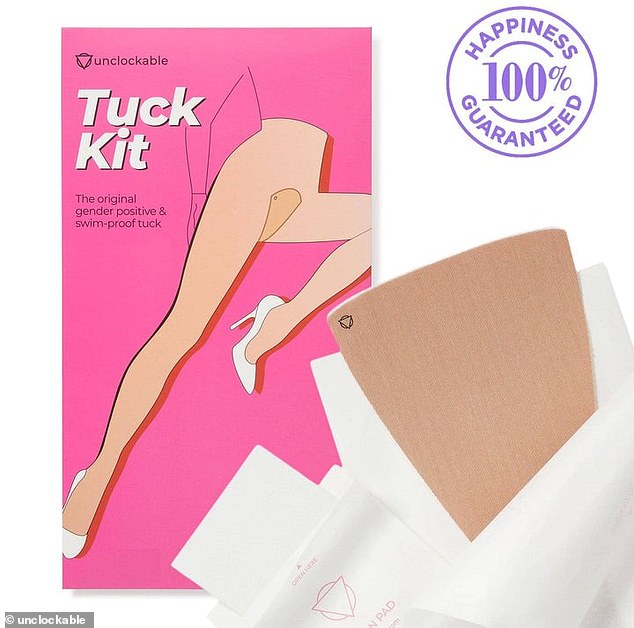The truth about ‘tucking’: Trans women reveal the downsides of scrunching up their crotch bulges – pain, itching, rashes and even INFERTILITY
It never looked comfortable – now we know it doesn’t.
Nearly two-thirds of male-to-female transitioners who squeeze their genitals to avoid a bulging crotch describe some form of pain as a result.
This is evident from the first study of its kind from the University of Virginia into ‘tucking’, as it is known.
Pain, itching and rashes are common problems in the sensitive area, researchers found.
But some tuckers make it worse.
In one of her videos, transgender TikToker Dylan Mulvaney showed viewers how to tape off her bump with a ‘tuck kit’

Researchers said “testicular torsion and infection” are among the biggest risks of tuck-in
At least one in ten developed urinary tract infections.
Others suffer from ‘twisted gonads’ and skin infections.
A handful of tuckers eventually become infertile because they grind their genitals too hard.
Nicholas Kidd, Kelley Mark and the other researchers said doctors should try harder to help trans patients.
They should “empathetically discuss tucking and its potential risks and benefits,” says the five-page study.
From corsets to push-up bras, people have used clothing to shape the way their bodies look for centuries.
The sharp increase in the number of men who identify as women in recent years has driven demand for clothing that makes them appear more feminine.
Few trans women undergo full genital removal, so tucking is preferred.
They do this to “relieve dysphoria and feel safer,” the study says.

Trans TikToker Dylan Mulvaney says ‘burying’ her bulge is ‘painful and involved’

Some trans women choose the ‘gaff’ to hide their genitals

Others buy a ‘tuck kit’ to tape down their bulging area and look more feminine
Trans TikToker Dylan Mulvaney is one such trans woman who fought against the ‘bulge’, as she calls it.
She wanted to achieve a “Barbie pocket” look, she said.
But the insertion, she added, was “very painful and complicated.”
Many trans women simply opt for “looser garments,” Mulvaney added.
Tuckers often use tape or tight underwear. Some use a special underwear known as a gaff.
Last year, the well-known brand Target released an LGBTQ+ range of ‘pleasure-friendly’ swimsuits for trans women.
Conservatives led a boycott of the brand.
For the study, researchers interviewed nearly 100 transgender and gender-diverse people, aged between 18 and 70.
They said they learned how to snack from friends, either by experimenting on their own or online.
More than four in ten said they started tucking as a child.
As adults, four-fifths of them slept, some for up to thirteen hours a day.

Trans women like Caitlyn Jenner say they have to take breaks from tucking, which becomes painful as the hours pass

Target last year introduced “please-friendly” swimwear for trans women in its LGBTQ+ range

The trans swimwear angered conservative shoppers, who led a damaging boycott of the retailer
Most said they take breaks during tucking because it gets painful.
Nearly two-thirds said tucking had caused them problems.
They ranged from gonad pain to itching, rashes, urinary tract infections, twists, skin infections and even infertility.
One in ten respondents had to go to a doctor or hospital because their condition was so serious.
And, they said, the more hours a trans woman puts in each day, the worse the problem becomes.
Less than a quarter of trans women said they spoke to doctors about tuck-in techniques.
Doctors should discuss “potential risks including reduced fertility, pain, itching, rash, and less likely but potentially more serious risks such as testicular torsion and infection,” researchers said.
Tucking was associated with “decreased sperm quality,” they said.
It was not clear whether those who had become infertile due to the plugging could reverse the damage.
